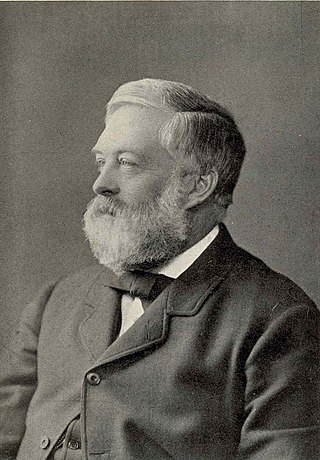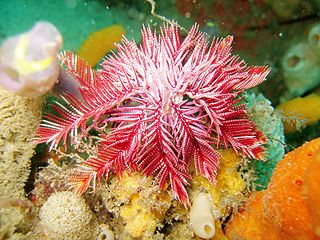
Crinoids are marine animals that make up the class Crinoidea. Crinoids that are attached to the sea bottom by a stalk in their adult form are commonly called sea lilies, while the unstalked forms, called feather stars or comatulids, are members of the largest crinoid order, Comatulida. Crinoids are echinoderms in the phylum Echinodermata, which also includes the starfish, brittle stars, sea urchins and sea cucumbers. They live in both shallow water and in depths as great as 9,000 meters (30,000 ft).

Sir Charles Wyville Thomson was a Scottish natural historian and marine zoologist. He served as the chief scientist on the Challenger expedition; his work there revolutionized oceanography and led to his being knighted.

Colossendeidae is a family of sea spider. Like most sea spiders, species in this family have four pairs of legs, except for three species with five leg pairs, including the first polymerous sea spider discovered, and one giant species that was the first sea spider discovered with six leg pairs.

Articulata are a subclass or superorder within the class Crinoidea, including the only living crinoid species. They are commonly known as sea lilies or feather stars. The Articulata are differentiated from the extinct subclasses by their lack of an anal plate in the adult stage and the presence of an entoneural system. Articulata first appeared in the fossil record during the Triassic period although other, now extinct crinoid groups, originated in the Ordovician.

Admiral Pelham Aldrich was a Royal Navy officer and explorer, who became Admiral Superintendent of Portsmouth Docks.

Bathycrinidae is a family of echinoderms in the class Crinoidea. It contains the following genera and species:

Charitometridae is a family of crinoids or feather stars in the phylum Echinodermata.

Metacrinus is a genus of stalked crinoids in the family Isselicrinidae. Members of this genus live on hard surfaces in deeper parts of the ocean. The genus has extant species and is also represented in the fossil record. Members of the genus grow to a maximum height of 60 centimetres (24 in) and are found in the eastern Pacific Ocean from Japan to Australia.

Bourgueticrinida is an order of crinoids that typically live deep in the ocean. Members of this order are attached to the seabed by a slender stalk and are known as sea lilies. While other groups of crinoids flourished during the Permian, bourgueticrinids along with other extant orders did not appear until the Triassic, following a mass extinction event in which nearly all crinoids died out.

Ptilometra australis, the passion flower feather star, is a species of crinoid. It is native to the coasts of southeastern Australia where it is found on reefs, in estuaries and bays at depths down to about 110 metres (360 ft).
Bathycrinus aldrichianus is a species of sea lily, a crinoid in the family Bathycrinidae. It is native to deep water in the North Atlantic Ocean. It was first described by the Scottish marine zoologist Charles Wyville Thomson and named in honour of Pelham Aldrich, a British naval officer and explorer. It is believed to be the crinoid living at the greatest depth.
Bathycrinus australocrucis is a species of sea lily, a crinoid in the family Bathycrinidae. It is native to the New Zealand region. It was described by D. G. McKnight.
Bathycrinus carpenterii is a species of sea lily, a crinoid in the family Bathycrinidae. It is native to the North Atlantic. It was described by Danielssen & Koren.

Bathycrinus gracilis is a species of sea lily, a crinoid in the family Bathycrinidae. It is native to the North Atlantic. It was described by Charles Wyville Thomson.
Bathycrinus mendeleevi is a species of sea lily, a crinoid in the family Bathycrinidae. It is native to the Pacific Ocean west of South America. It was described by A. N. Mironov.

Bathycrinus is a genus of crinoids.

Florometra serratissima is a species of crinoid or feather star in the family Antedonidae. It is found off the Pacific coast of North America, usually in deep water.
Ailsa McGown Clark (1926–2014) was a British zoologist, who principally studied echinoderms and was a specialist on asteroidea. She worked at the Natural History Museum for most of her career.










